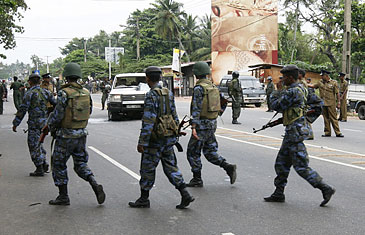
Troops surround the site of a bomb blast that killed Sri Lankan politician D.M. Dassanayake in the town of Ja-Ela, outside Colombo, Jan. 8, 2008
The Sri Lankan government's decision this week to officially pull out of a 2002 cease-fire agreement with the rebel Liberation Tigers of Tamil Eelam (L.T.T.E.) was merely a confirmation of what Sri Lankans have known for the past 18 months: war has returned to the beautiful Indian Ocean island. It never really went away, of course; Hundreds have been killed in skirmishes since the Norway-brokered cease-fire took effect six years ago and a resumption of major battles in 2006 has made a mockery of the truce.
But with Sri Lanka's government beset by an inflation rate nearing 20% and growing dissatisfaction among the Buddhist Sinhalese majority in the country's south, it appears to have settled on reopening hostilities as a way to shore up flagging support. The government has portrayed the long-running civil war as eminently winnable, publishing daily updates announcing that 10, 20 or more Tigers have been killed and fueling the idea that the insurgency is on its last legs. It's a risky strategy, but the government "has no other platform on which to secure public support," says Paikaisothy Saravanamuttu, the Executive Director for the Center for Policy Alternatives, a Colombo-based think-tank. "If it cannot sustain it by showing victory, it is bound to be at the receiving end of a backlash."
It is difficult — sometimes impossible — to adequately assess the situation on the ground. Media organizations are not allowed access to the theater of war, while journalists who attempt to counter or disprove the government's statements are branded traitors by government officials in state-owned media. In a country where journalists have increasingly come under threat from all sides, such labels are often sufficient incentive to toe the government line. Last week, in an interview with the state-controlled Dinamina newspaper, the Army Commander Sarath Fonseka singled out the media as the greatest obstacle to defeating the Tigers.
Still, what reports are available make it clear that Sri Lankan government forces and Tamil Tiger fighters are poised along the line of control in the country's north, gearing for inevitable battles in the coming weeks. Civilians in the area have reported that heavy shelling and artillery exchanges could be heard through last week. Clashes during the first weekend of 2008 killed over 70 combatants, including Shanmuganathan Ravishankar, the head of Tiger military intelligence.
But the Tigers are unlikely to go quietly, as a bomb attack Tuesday that killed minister for nation building D.M. Dassanayake outside the capital Colombo aptly proved. Government forces have lately been unable to match their successes of early 2007, and even high-ranking military officials have warned that clashes in the north are likely to be bloody and long. A former Air Force commander who saw action against the Tigers agrees that a win is far from assured. "Total victory is not all that easy," the former officer told TIME, speaking on condition of anonymity because he fears reprisals if identified. "It is more complicated than eliminating the Tigers." Government soldiers, he says, are likely to "get bogged down with no clear plan evident on how to deal with the inevitable flow of refugees. Further, unlike the east, the Tigers are very well fortified [in the north]. They have survived sustained aerial bombardment and seem prepared for the long haul."
The Tigers' defenses along the front lines are heavily mined and booby-trapped, making progress over land painstakingly slow. They have also positioned artillery guns behind the front lines to thwart any large movement by the Army. "We are ... waiting for their eventual Sri Lanka Army offensive," senior Tiger leader K. V. Balakumaran said recently. "We are cognizant of the enormity of the possible disaster that can unfold." It's a possibility the Sri Lankan government would also do well to consider.
